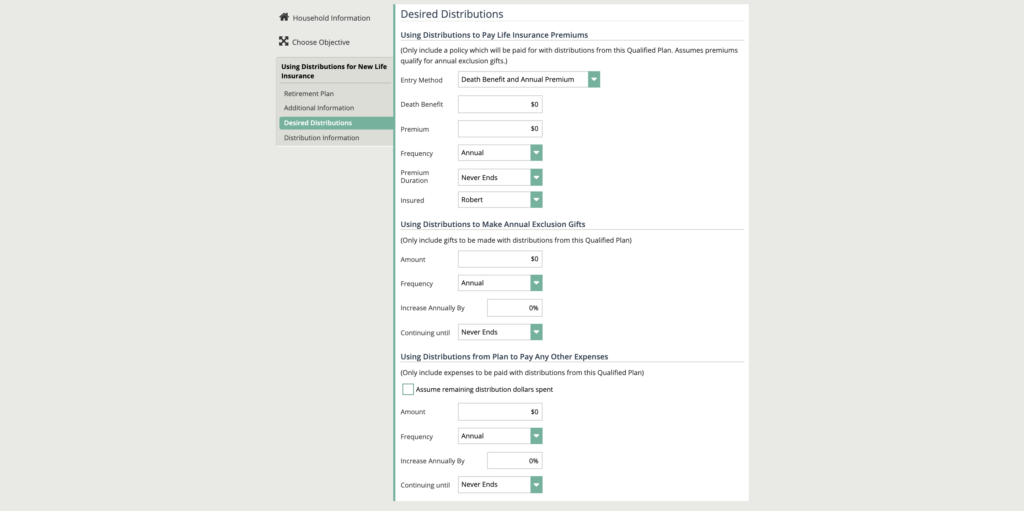Additional information
After completing the retirement plan tab for this objective, you are presented with the opportunity to enter any non-qualified assets that your client may wish to use for this plan. Additionally, you must enter the income tax rates and use the drop-down box to dictate when or if they will change.
Lastly, the Estate Assumptions section is designed for estates of less than approximately $10 million. Existing life insurance policies and prior taxable gifts are not considered in these calculations. The portability of unused spousal exemption is assumed, but not from a prior spouse.
Desired distributions
When deciding to use distributions to pay your clients life insurance premiums only include a policy which will be paid for with distributions from this Qualified Plan.
If your client wishes to use distributions from this qualified plan to make annual exclusion gifts, please fill out the section under “Using Distributions to Make Annual Exclusion Gifts.” These will be gifted without incurring a gift tac or affecting the unified credit.
The last section for the “Desired Distributions” tab is relevant for any client that wishes to use distributions from this qualified plan to cover the cost of any other expenses.

Distribution information
At the top of the Distribution Information tab under the Required Minimum Distribution objective is an option to select if your client qualifies to delay distributions past age 72. In order to qualify for this the client must remain actively employed AND own less than 5% of the Plan Sponsor (business or employer) or their Plan is a 403(b) plan that is not a government or church plan.
The distribution method options include the
- Safe Harbor Method under IRC Sec. 72(t)
- Distribute an annual distribution
- Scheduled distribution
Distribution Assumptions
Single vs. Uniform Lifetime Table
The uniform distribution table is the life expectancy table to be used by all IRA owners to calculate lifetime distributions unless your beneficiary is your spouse who is more than 10 years younger than you.
The single life expectancy table is based on the age after the IRA owner’s death. That factor is reduced by one for each succeeding distribution year.
Many people are opposed to paying the penalty tax for early distributions and ask the question, “Is there a way to avoid it?” Yes, there is: the Safe Harbor distribution methods. Following the rules of the Safe Harbor distribution methods is one of the exceptions for the 10% early distribution penalty. There are three methods that qualify as a Safe Harbor method:
- Life expectancy method is calculated the same way as Required Minimum Distributions (RMD), but it simply starts at a younger age. It’s a variable annual payment that fluctuates with the account balance each year. It is usually the smallest initial annual payment and the annual payment may increase or decrease if the account earns more (or less) interest than assumed in the projected calculations.
- Amortization Method is a level annual payment amortized over life expectancy that, once calculated, the distribution remains the same each year. It is usually a lower annual payment and slower spend-down of the account, and there are more choices for life expectancy calculation.
- Annuity Method is very similar to the amortization method but it uses a level annual payment based on the life only annuity tables. It is usually the highest annual payment and fastest spend-down of the account. It is the least flexible method.
